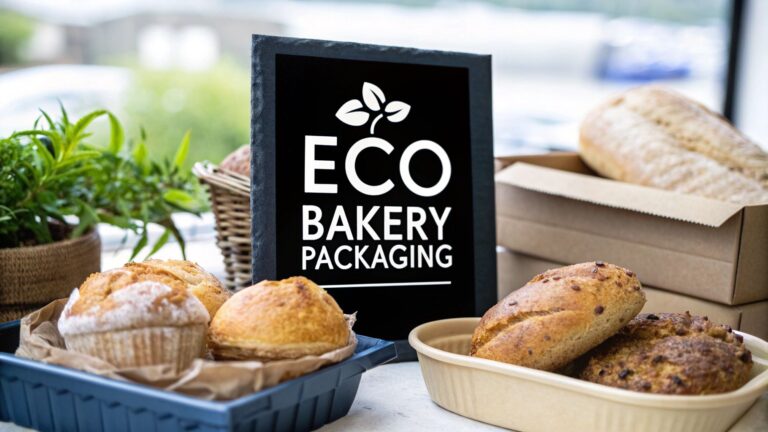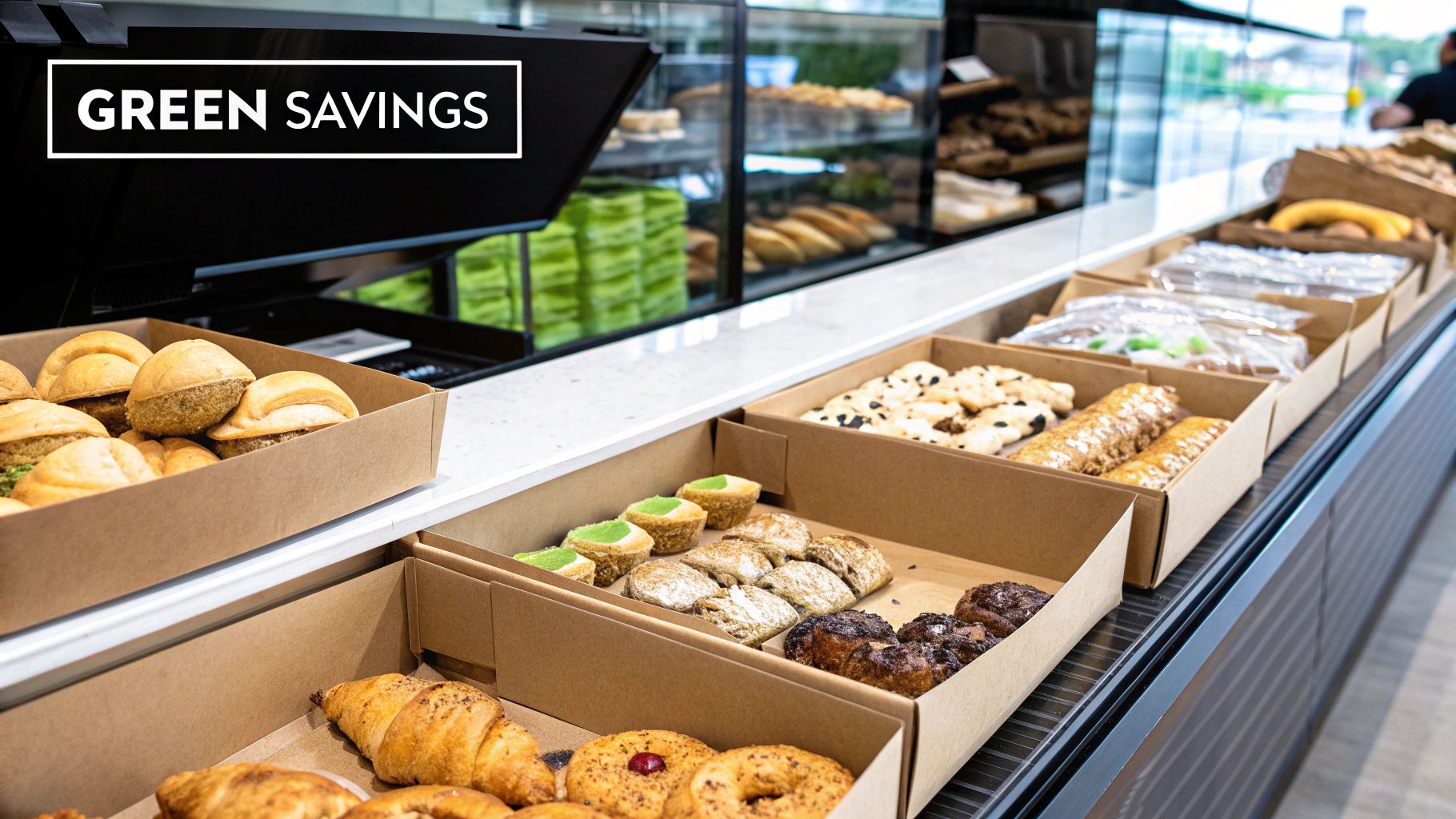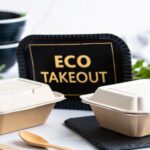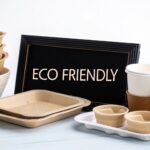Why Customers Are Demanding Greener Bakery Packaging
Consumer behavior is shifting. More and more, people consider the environmental impact of their purchases, even something as simple as bakery packaging. This isn’t just a passing trend; it’s a fundamental change in how consumers view their role in protecting the planet. Bakeries must adapt to meet these evolving expectations to stay competitive.
The Rise of the Eco-Conscious Consumer
Today’s customers look beyond just taste and quality. They’re increasingly scrutinizing the entire experience, from ingredients to packaging. A delicious croissant loses its appeal if wrapped in excessive plastic destined for a landfill. This growing awareness drives demand for eco-friendly bakery packaging. Over 54% of consumers actively choose products with sustainable packaging, pushing bakeries toward compostable wraps and plant-based containers.
This trend reflects a larger market shift, with the global eco-friendly food packaging market projected to reach $408.44 billion by 2029.
To better understand consumer preferences, let’s look at the following table:
Consumer Preferences for Sustainable Bakery Packaging
| Consumer Preference | Percentage of Consumers | Impact on Purchasing Decisions |
|---|---|---|
| Compostable Packaging | 45% | Significant |
| Recyclable Packaging | 60% | High |
| Reduced Packaging | 55% | Moderate |
| Biodegradable Packaging | 35% | Moderate |
These statistics clearly demonstrate that consumers are actively seeking sustainable packaging options. This trend is influencing their purchasing decisions, making it a crucial factor for bakeries to consider.
Regulatory Pressures and Competitive Advantages
The push for greener practices isn’t solely consumer-driven. Governments worldwide are implementing regulations to reduce waste, including bans on single-use plastics and recycling targets. The EU is considering a 65% recycling target by 2030, while Wales aims for zero waste by 2050.
These regulations create a level playing field, urging all bakeries to adopt sustainable solutions. Forward-thinking businesses see these regulations not as obstacles but as opportunities. By embracing eco-friendly bakery packaging, bakeries can position themselves as sustainability leaders, attracting environmentally conscious customers and building a positive brand image.
Turning Sustainability Into a Selling Point
Imagine two bakeries side-by-side. One uses conventional plastic; the other proudly displays its commitment to compostable materials. Which would you choose? For many, the answer is clear.
Sustainable packaging is a key differentiator. It’s a tangible way for bakeries to communicate their values and resonate with environmentally responsible customers. This can increase customer loyalty and even justify premium pricing for ethical and sustainable products. Using eco-friendly materials enhances a bakery’s brand story, creating a narrative of care that resonates with a growing market segment.
Revolutionary Materials Transforming Bakery Packaging
The bakery packaging world is shifting. It’s moving from traditional materials to more sustainable options. This change comes from consumers wanting eco-friendly choices and the need to lessen environmental impact. But what does “eco-friendly” actually mean for bakery packaging? It means using materials that are biodegradable, compostable, or recyclable. This minimizes waste and reduces the use of petroleum-based plastics. This isn’t just about switching materials; it also affects functionality, how things look, and the customer experience.
Biodegradable Wonders: From Mushrooms to Sugarcane
Innovative materials are changing how we package baked goods. Mushroom packaging uses agricultural waste and mycelium, the root structure of mushrooms. This creates a compostable and durable replacement for Styrofoam. Bagasse, a byproduct of sugarcane processing, makes sturdy containers ideal for takeout. These materials decompose naturally and insulate well, keeping baked goods fresh.
PLA (polylactic acid) is another key material. It’s a bioplastic from renewable resources like cornstarch or sugarcane. PLA liners offer a compostable barrier against moisture and grease. They’re perfect for lining boxes and wrapping pastries. These materials are a big change from traditional plastics. They offer a more sustainable way to package while keeping products fresh and high-quality. This focus on natural and renewable resources greatly reduces the need for fossil fuels and lowers the carbon footprint of bakeries.
Navigating the Material Landscape: A Comparative Look
Choosing the right eco-friendly material depends on the item and its packaging needs. Delicate pastries need support, while breads need breathable, protective packaging.
The following data chart shows the strengths and weaknesses of different sustainable materials:
The data chart compares various materials based on compostability, insulation, moisture resistance, cost, and overall environmental impact. As the data chart shows, mushroom packaging is great for compostability and insulation, but can be pricey. PLA liners offer a good balance of moisture resistance and biodegradability. Bagasse is strong and affordable. Recycled paper, though common, requires careful sourcing and checking for contamination.
To further compare these materials, let’s look at a table summarizing their key properties:
Comparison of Eco-Friendly Bakery Packaging Materials
| Material Type | Best For | Decomposition Time | Moisture Resistance | Cost Factor | Environmental Impact |
|---|---|---|---|---|---|
| Mushroom Packaging | Delicate pastries, insulation | 45-90 Days | Moderate | High | Very Low (Compostable) |
| Bagasse | Takeaway containers, hot items | 60-90 Days | Moderate | Low | Low (Compostable) |
| PLA Liners | Moisture and grease-prone items | 90-180 Days (Commercially Compostable) | High | Moderate | Low (Compostable) |
| Recycled Paper | Breads, dry goods | Variable, depends on processing | Low | Low | Moderate (Recyclable) |
This table provides a quick overview of the various eco-friendly packaging options available for bakeries, highlighting their suitability for different products and their overall environmental impact.
The Future is Green: Growth and Adoption of Eco-Friendly Packaging
Growing consumer awareness of environmental issues and stricter regulations are changing the packaging industry. By 2034, the eco-friendly food packaging market, including bakery solutions, is predicted to reach $392.37 billion. It’s expected to grow at a 6.97% CAGR from 2025. This growth is fueled by corporate sustainability pledges and consumer demand. Major brands are actively trying to reduce their environmental impact. This growth shows a larger trend toward sustainability. Businesses and consumers recognize the need for responsible practices.
Innovations like smart packaging for food safety and better supply chain collaborations are speeding up the use of eco-friendly solutions. Countries like Germany and Austria, with recycling rates of 56% and 52% respectively, are leading in waste reduction. They’re setting new standards for sustainable practices. This global shift toward eco-conscious packaging shows the growing commitment to reducing environmental impact. It demonstrates the move toward a more sustainable future for the food industry.
Making The Switch: Real-World Implementation Strategies
Moving to eco-friendly bakery packaging doesn’t have to be overwhelming. It’s a transition you can make gradually, and many bakeries have already done it successfully. By learning from their experiences, you can implement these changes smoothly and see positive results.
Phased Approach For Implementation
A phased approach lets you integrate eco-friendly bakery packaging step by step. Start with easy items like cookies or muffins, which transition well to paper bags or compostable boxes. Then, move on to more challenging items like cakes or pastries that need specialized packaging. This allows for adjustments and learning along the way.
- Phase 1: Low-Hanging Fruit: Begin with simple swaps. Trade plastic bags for paper and use compostable boxes for individual treats.
- Phase 2: Expanding the Range: Gradually introduce sustainable materials for your more delicate products. Explore compostable liners and wraps for items that need protection from moisture.
- Phase 3: Comprehensive Transition: Work towards using eco-friendly materials for everything you sell. This might involve finding new suppliers or even redesigning some of your current packaging.
Supplier Selection And Staff Training
Finding dependable suppliers of eco-friendly packaging is essential. Look for certifications like ASTM D6400 or EN 13432 to confirm materials are truly compostable. After choosing your materials, staff training is key. Your team needs to know how to use the new packaging correctly and explain its benefits to customers.
- Research Suppliers: Compare pricing, minimum order quantities, and certifications. Find the supplier that aligns with your business needs.
- Build Relationships: A good relationship with your suppliers will ensure quality and reliable deliveries.
- Train Your Team: Give clear instructions on how to use, store, and dispose of the new eco-friendly materials.
Communicating With Customers
Be upfront about your switch to eco-friendly bakery packaging. Explain why you’re making the change and highlight the environmental benefits. This builds customer loyalty and attracts environmentally conscious shoppers. Try adding a small note to your packaging or posting signs in your bakery. Use your social media platforms to share your sustainability journey.
This open approach can turn a packaging change into a marketing advantage. The sustainable packaging market is growing rapidly, expected to be worth $423.56 billion by 2029, up from $292.71 billion in 2024. Consumer demand, with 54% of consumers actively seeking sustainable options, and regulations like the EU’s Single-Use Plastics Directive fuel this expansion.
Collaborative Purchasing And Incentives
Team up with other local bakeries to buy supplies together. This can reduce costs through bulk orders and give you better leverage with suppliers. Also, look into grants or incentives for businesses adopting sustainable practices.
- Partner With Local Businesses: Explore combined purchasing to access bulk discounts.
- Seek Out Grants And Incentives: Research available programs that might offset the initial costs of eco-friendly packaging.
By following these strategies, you can transition to eco-friendly bakery packaging while remaining profitable and boosting your brand’s reputation. This change is good for the planet and presents your bakery as a responsible and future-focused business.
Designing Packaging That Customers Actually Prefer
The idea that eco-friendly packaging means sacrificing aesthetics is simply not true. Leading bakeries are demonstrating that sustainable options can be just as visually appealing, if not more so, than traditional packaging. This shift reflects a growing consumer desire for businesses that prioritize environmental responsibility.
Balancing Aesthetics and Sustainability
Transitioning to eco-friendly bakery packaging doesn’t mean abandoning your brand identity. It’s about discovering creative ways to incorporate your existing branding onto sustainable materials. For instance, consider using vegetable-based inks for printing on recycled cardboard or bagasse containers. This preserves the vibrancy of your logo and design while lessening your environmental footprint.
- Maintain Brand Colors: Select eco-friendly inks that align with your current color scheme.
- Adapt Your Logo: If needed, adjust your logo slightly to look its best on textured surfaces like recycled paper.
- Embrace Minimalism: A minimalist design can enhance the natural aesthetic of eco-friendly materials.
Showcasing Your Products: Visibility Windows and Design
Customers still value seeing the treats they are purchasing. Incorporating visibility windows into your eco-friendly bakery packaging addresses this desire. Using PLA (polylactic acid) film, a compostable material derived from renewable resources, creates a clear window that showcases your products without compromising your sustainability efforts.
Also, consider the overall structure and design of your packaging. Eco-friendly materials can present unique design possibilities. The natural texture of unbleached paper bags, for example, can evoke a rustic and artisanal look.
- Strategic Window Placement: Showcase the most enticing aspects of your baked goods through careful window placement.
- Consider Shape and Structure: Explore distinctive box shapes and folding techniques to create visually appealing packaging.
- Highlight Natural Textures: Leverage the inherent textures of eco-friendly materials to elevate your brand’s visual appeal.
Functionality First: Moisture Barriers and Structural Integrity
Eco-friendly packaging must, of course, protect your baked goods. Moisture barriers are essential for preventing sogginess and preserving freshness. PLA liners provide a compostable solution for creating a barrier against moisture and grease.
The structural integrity of your packaging is equally important. Bagasse containers, made from sugarcane fiber, are a robust and compostable option perfect for items requiring extra support. They offer excellent insulation and are suitable for both hot and cold products.
- Choose Material Wisely: Select materials offering the right amount of moisture protection for your specific products.
- Prioritize Strength and Durability: Ensure your packaging can withstand handling and transportation without damage.
- Test Your Packaging: Thorough testing ensures your chosen materials and design effectively protect your products.
Communicating Your Values
Your packaging is more than just a container; it communicates your brand’s values. Use it to share your sustainability story. A straightforward message explaining your commitment to eco-friendly bakery packaging can resonate powerfully with customers. This reinforces your brand’s commitment and builds trust with environmentally conscious consumers.
Your packaging can also educate customers about proper disposal. Clearly labeling your packaging as compostable or recyclable, along with clear disposal instructions, empowers customers to participate in the sustainability cycle and maximizes the environmental benefits of your choices. By prioritizing both aesthetics and functionality, you can create eco-friendly packaging that customers appreciate and that aligns with your brand’s values.
Navigating Certifications That Actually Matter
With the increasing demand for eco-friendly bakery packaging, choosing the right certifications can feel overwhelming. Many claims sound impressive, but what truly benefits your bakery and connects with your customers? This section helps you avoid greenwashing and focus on certifications that make a real difference.
Decoding Key Standards: Compostability and Biodegradability
Two terms often cause confusion: compostability and biodegradability. While both relate to decomposition, they aren’t interchangeable. Biodegradability simply means a material breaks down into natural substances over time. Compostability, however, requires the material to break down under specific conditions, leaving no harmful residue. For bakery packaging, verifiable compostability is essential.
- ASTM D6400: This standard signifies that a product will fully compost in a municipal or industrial composting facility. Look for this certification on items like bakery boxes and takeout containers.
- EN 13432: The European equivalent of ASTM D6400, this certification holds the same weight and ensures compostability under controlled conditions.
- BPI Certification (Biodegradable Products Institute): BPI Certification verifies that a product is compostable in industrial composting facilities.
These certifications assure your packaging will break down correctly, reducing landfill waste.
Verifying Supplier Claims: Due Diligence for Eco-Friendly Choices
It’s crucial to verify your suppliers’ claims. Don’t simply accept their word. Look for supporting documentation and ask about specific certifications their products hold. Transparency is paramount.
- Request Certificates: Ask your suppliers for copies of their certifications and verify the certifying body is reputable.
- Independent Testing: Consider independent testing to confirm compostability claims, particularly for new or unfamiliar materials.
This due diligence ensures you are genuinely using eco-friendly bakery packaging, building customer trust and lessening your environmental impact.
Beyond Compostability: Other Important Certifications
While compostability is vital for eco-friendly bakery packaging, other certifications are also important:
- Forest Stewardship Council (FSC) Certification: FSC Certification certifies that paper products originate from responsibly managed forests, promoting sustainable forestry.
- Recycled Content: Look for packaging with a high percentage of recycled content, reducing the demand for virgin materials.
Communicating Certifications: Transparency Builds Trust
Communicate your certifications to your customers. This builds trust and showcases your dedication to sustainability.
- On-Product Labeling: Display certifications clearly on your packaging.
- Website and Marketing Materials: Explain the meaning of these certifications on your website and social media.
- In-Store Signage: Use signage in your bakery to emphasize your use of eco-friendly materials and certifications.
Clear communication can be a valuable marketing asset, attracting environmentally conscious customers.
Staying Ahead of the Curve: Region-Specific Regulations
Regulations surrounding eco-friendly bakery packaging are different depending on the region. Stay informed about current and future laws in your area to ensure your bakery remains compliant.
- Local Government Websites: Check your local government’s website for packaging regulations.
- Industry Associations: Join industry associations to keep up-to-date on legislative changes.
By monitoring these changes, you can adjust your packaging accordingly, minimizing potential business disruptions. Choosing certified eco-friendly bakery packaging isn’t just good for the environment; it’s a wise business decision that resonates with today’s values-driven consumers. By understanding these certifications and communicating them effectively, you can strengthen your brand, attract customers, and create a more sustainable future.
The Real Economics of Sustainable Bakery Packaging
Switching to eco-friendly bakery packaging often raises concerns about cost. However, a closer look reveals that the financial impact is more nuanced than just the initial price. By examining both the investments and potential returns, bakeries can make informed decisions that benefit both their profits and the planet.
Initial Investments and Ongoing Costs
Upfront, eco-friendly materials are often more expensive than conventional packaging. This can include:
- Material Costs: Compostable and biodegradable materials can have a higher initial cost.
- Transition Costs: Switching suppliers, updating inventory systems, and training staff can also add to the initial investment.
Ongoing costs can also differ. Compostable packaging may require specific disposal methods, potentially adding extra fees. However, these initial and ongoing costs should be weighed against the potential long-term financial advantages.
Surprising Areas of Savings
Many bakeries find unexpected cost savings after going green with their packaging. These can include:
- Reduced Waste Disposal Costs: Some municipalities offer lower rates for compostable waste, lowering overall disposal expenses.
- Increased Customer Loyalty: Consumers are increasingly choosing to support businesses that share their values. This leads to better customer retention.
- Premium Pricing Opportunities: Environmentally conscious customers are often willing to pay a bit more for sustainably packaged goods.
Calculating a Comprehensive ROI
Understanding the true return on investment (ROI) requires looking beyond just material costs. A thorough calculation should factor in:
- Customer Acquisition and Retention: Attracting and retaining eco-conscious customers increases revenue over time.
- Brand Enhancement: A commitment to sustainability elevates your brand image, potentially increasing recognition and market share.
- Risk Mitigation: Sustainable practices can prepare your bakery for future regulations, avoiding potential penalties and operational disruptions.
Negotiation Tactics and Collaborative Approaches
Strategic negotiation can help secure better pricing from suppliers. Consider these tactics:
- Long-Term Contracts: Negotiate lower per-unit costs by committing to a long-term supply agreement.
- Bulk Purchasing: Team up with other bakeries to buy in larger quantities and leverage volume discounts.
Collaboration can extend to resource sharing, too. Partnering with local businesses can create opportunities for shared composting facilities or delivery routes, reducing individual expenses.
Budgeting for a Sustainable Transition
Successfully transitioning to eco-friendly bakery packaging requires careful budgeting. Consider this framework:
- Phased Implementation: Begin by switching a portion of your products to sustainable packaging, gradually increasing the percentage as your budget permits.
- Cost Analysis: Carefully track expenses before and after making the switch to pinpoint further areas for cost optimization.
- Contingency Planning: Include a financial buffer in your budget to handle unforeseen costs that may arise during the transition.
By analyzing both costs and benefits, bakeries can implement sustainable packaging that aligns with their financial goals and contributes to a greener future. Interested in exploring eco-friendly options? Check out MrTakeOutBags.com for a wide variety of sustainable solutions.








Comments are closed.